Tunisian Entrelac
There are 2 types of tunisian entrelac – I am now working on a written tutorial for both. So, why is this page here?
Well, there is a commonly known entrelac method, which arguably you make a diamond shape, but its a square with zigzag edges, where you can make it rectangular if you wish but in rough description if its square, you draw lines from corner to corner, crossing in the middle and then the 4 triangles you have each one all the squares in it go the same way – this is very suitable for multiple colours..
Then there is the entrelac method that eluded me for months, I had a few goes and always ran into a problem, this one is where any given square – the squares on the 4 sides, are at 90 degrees to the square you started at, as a result you get a basket weave effect with the squares going .
Common method: for rightys, if you’re lefty you will know you work the other way, so chaining out you need to mirror it all.
In words only for now. Pictures to follow I hope. Assuming basic stitch is TSS – tunisian simple sitch (it doesnt have to be of course.)
If you do 2 colous you can slipstitch out to not bother cutting yarn and making tails and doing all that dreaded sewing after, if its more than 2, you need to cut and sew, sorry. 1 of course you can just keep going 🙂
Round 1
pick your starting square, it should contain 1 more stitch across than it does rows, lets say 7 by 6 (the 6th is the bind off row).
Round 2
If you are changing colours, now you join in a corner, and chain out 6, then with the original square on the left, TSS the 6 and through the first row loop on the left which counts as your 7th, do the 5 rows and bind off for the 6, this leaves you back at the corner of the first square.. chain out, and repeat for all 4 sides.
Heres a picture of part way round round 2! Im about to chain out to do the last square in the round.
Round 3
If you are you now have a little cross, starting at an outer edge, just like you did for round 2, take the bottom right of an end and chain out 6, and extending the cross, working just like round 2, do 5 rows and bind off, now you;re at the top left of that square, and you’ll pick up the stitches across its top, and use the right hand stitches of the square to the left of it. When you get to the next point in the diamond and have no square on the left, you chain out 6, and work with that square to the left so you have turned the corner, repeat for all 4 sides.
Now you have 3 rounds, 4th round and all other rounds work like round 3, start at a point, chain out, following its diredction like you can see bottom right in my picture, and then work to the next point chain out and turn and work up the next side using the previous rounds squares as bottoms and lefts for all the new squares.
As it grows those triangles become more apparent, as you can see, in the following pictures you can see because of the stripes that each square in a given triangle pointing to the middle, all the stripes are going the same way.
Last round you can do the last round in a different colour to make a striking border, or you can make triangles to “square” it off. as you can see from the smaller initial pictures you end up with zigzags otherwise, to make the triangles, you now want to try and work in a straight line, so, you start with a single tss, then 2, 3, 4 each row expanding to fill the gap, and then reducing to fill the gap to make a triangle. Better explaination soon!
The less common Entrelac method
This one really only has 3 things you need to know.
Lets assume you’re making squares like before, so its 7 stitches 6 rows inc bind off row.
Round 1
make square 1. then using the old left hand side of the square, use that as the base stitches (no square on left) and make the next square so you have one square on top of the original square now below and at 90 degrees. Now do the same again, use the 2nd square as the base, do another square, finally use the 3rd square as the base, and the 1st as a left square.
Round 2
OK, here is singularly the most important 2 aspects of this version of entrelac.
The first square you do in any round must be at 90 degress to the last round eg its not working “up” with the sqaure as the base, but you chain and use it as a left.. Why? because when you complte you can use it as the left hand side to go up, if you dont you would need it to be a top – and your yarn would end the wrong side and it goes incredibly wrong.
Second. You need to join on the RIGHT hand side, yes you read that right. Its a bit weird, but.. here goes. So, on even rounds
Please note these pictures shore me making the key mistake, eg that 5th square is working up not across.. Pictures maybe video to come
Ok these pictures stop at the tricky bit. Here you see it looks like Im stuck in a corner, well yes and no. This is where you would need to join to the square you just made on the right, and use the last round as your base, to join on the right you have to take your hook out of the loop, and pass through the stitch on the right and pull the loop through.
as you can see from the end of round 2 you now have the basket weave look – its not hugely clear but you can see that each row is like a checkerboard, the squares are always at 90 degress to the ones on any flat side. For further rows, apply round 2 logic, till you’re done!
Here you can see I did round 3 in a different set of colours
I promise to do better pictures and instructions later – but I hope this willl give you all a guide on how this works!

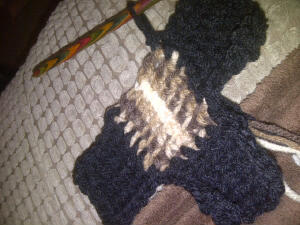

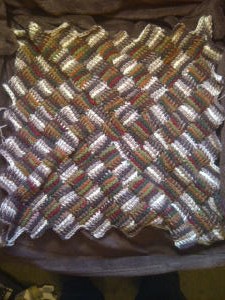

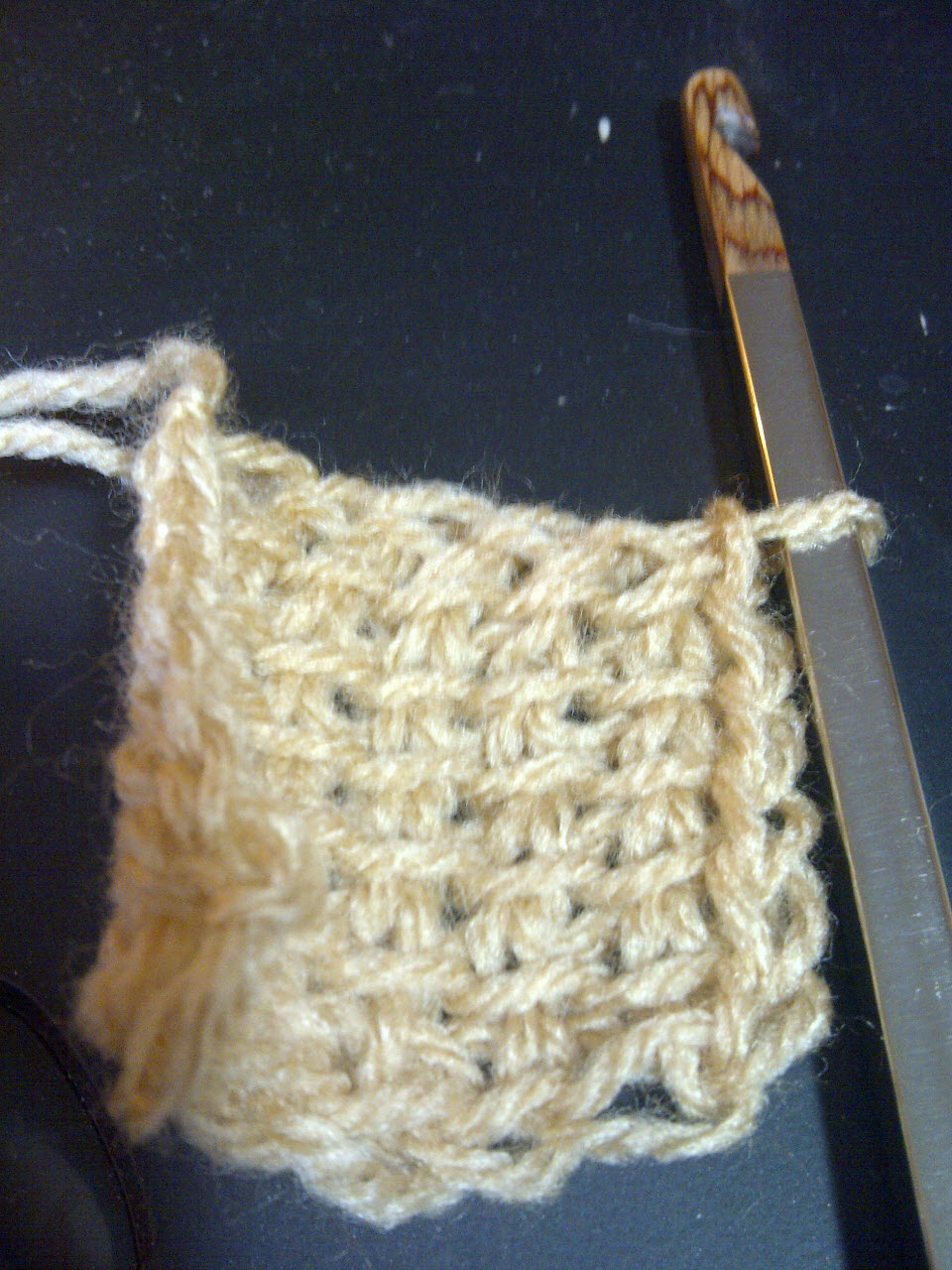


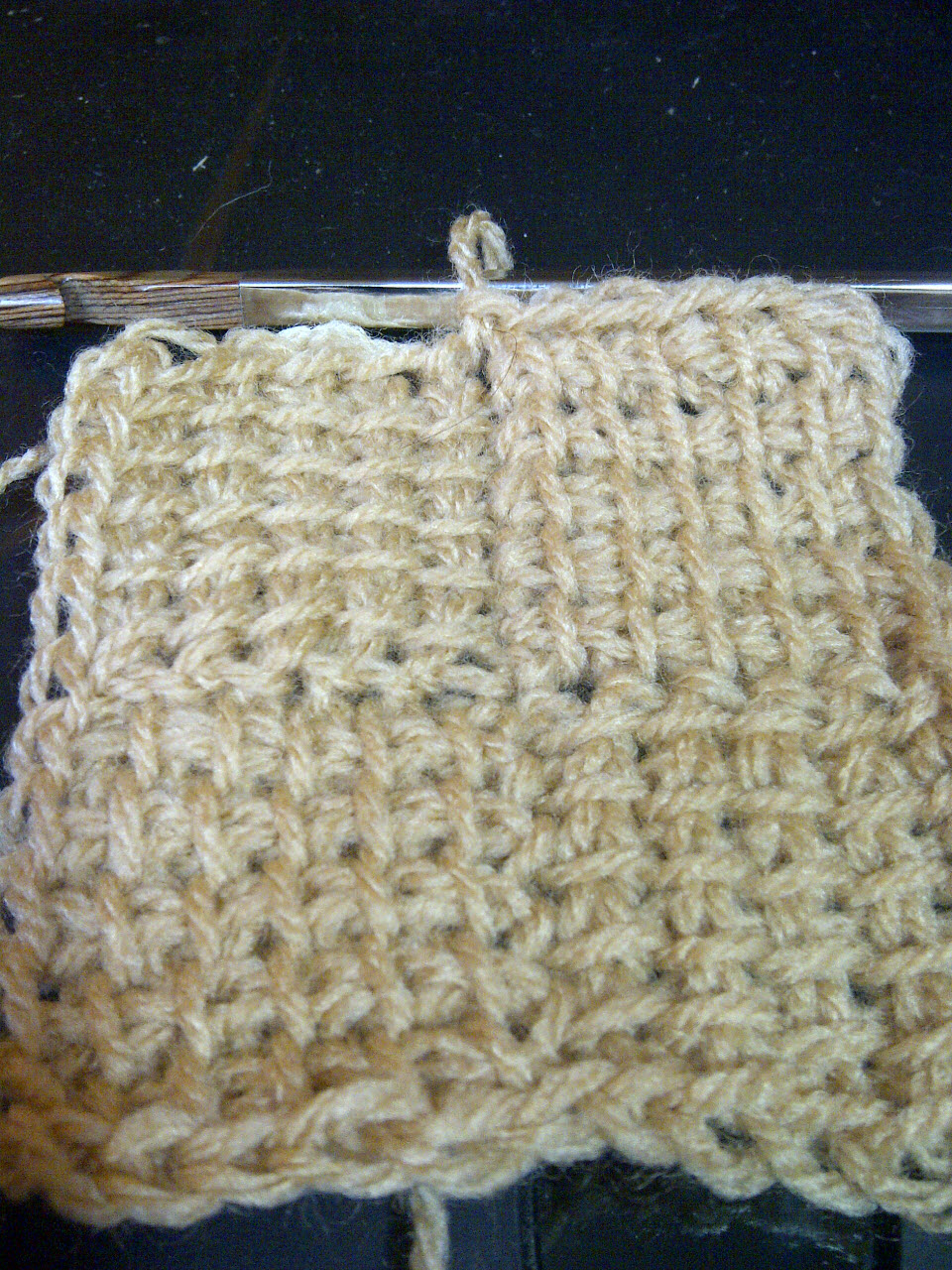


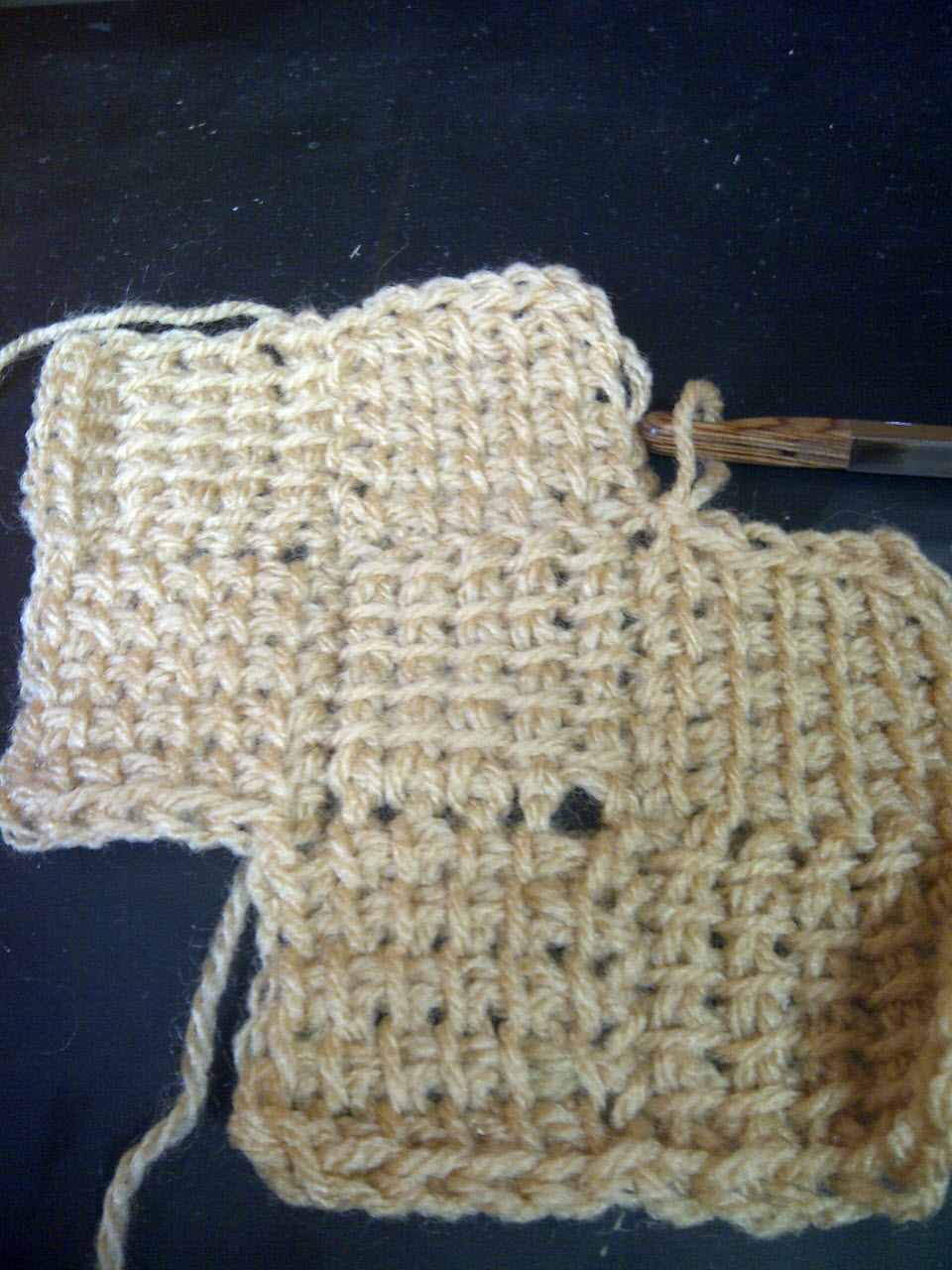
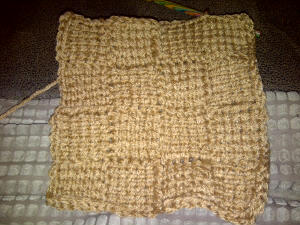
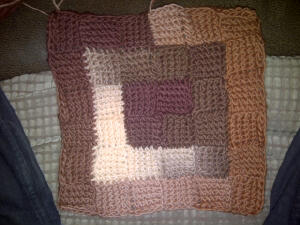

I have done Entrelac but not the Basketweave type
are there any more instructions ? would appreciate it if you would email them
Thank You
another question
how do you join to the on round 2 for the less common entrelac ?
Thank You
With the one that ends up like a basket weave, you must always start the next round on a square that starts by chaining out, this is the most important part, otherwise, come the last square of the round you wont be able to get to the edge. If you’re changing colours its simpler, as you can start anywhere where such a square would be appropriate and chain up and start the left joining square as needed, if you’re doing 1 colour, you need to slip stitch across the top of the square next to the last one in the previous round, eg to get to the next square that needs to be horizontal not vertical as you hold the peice when you finish the round.
I am no artist, but I will try and do some form of diagram and enhance these instructions.. as its a really lovely finish, but it does seem odd next to no one else lists instructions
Thank You
I would appreciate it .
I am stumped on the round 2 going back to the right ( picture no 7 )
how do you do it ? go the right and do a square ?
Thank You for your answers
You go forward to the left 🙂
Thanks. I been looking for borders for this type. There is one I’m doing as a scarf and it shows how to do this but never said turn to make it like a four square. The one I’m doing is more of a diamond shape. and tt makes you go around the pattern as it is worked. Again thanks for this suggestion pattern as I’m calling yours because it gives me a idea how to improve the pattern in the scarf.
Aww, thanks. It’s a bit of a pain making the last square as it is joined on 3 sides but it does make excellent results
Is there a written pattern someplace? I am not a new crocheter and I don’t understand how to start this.
Thanks, Shell
Not as yet. Im not confident in pattern sharing..
So you said square 5 is wrong (even though it looks right) – that I need to chain out to start the next square/round – but if you chain out from the end of square 4, then square 5 is the same direction as square 1.
Do I slip stitch to the end of square 1, chain out, and start the next round?
You need to start on a square working with joins to the current work on the left, how you get there, doesnt matter so much.
Ps i will redo these instructions this year. Promise.
Is there a written pattern yet on the 2nd entrelac method ?
Thank You
The description is on the page, there isnt a totally 100% guide because there just wasnt the interest. However, the basics are in my page, and i do keep meaning to write further instructions in a bit more detail. Do you have a question? Are you stuck on a bit?
Thank You for your reply I figured it out
what size hook would you recommend ?
One a size or so bigger than the yarn would normally recommend
I am trying to make a rug based on a pixel pattern I put together. Entrelac seemed the most logical to keep the ongoing square design in the shape without having to whipstitch a bunch of granny squares together. That being said, all the patterns I could find were worked in the diagonal ‘diamond’ style until I came across your page here.
So first thing, thanks!
Second, can you clarify how you got out of the corner space in round two? And how you filled in that last corner? I’m trying to find a way to work it in a round without having to detatch and reattach the yarn.
Thanks!
If you are making a picture, you would end up cutting and changing yarns anyway, however, the ket to the corner is keep working but you need to attach on the right as well, to do this complete the row so you have one loop, take your hook out, poke it through the right hand square and pull through the loop, you will do this each row.
Thank you for this information. I was able to follow your instructions and make a rectangular swatch. I am trying to figure out if one can make this using a triangle base row like knitted entralac. Have you played around with that method? Thanks again.
You can sort of, you can. Go round the edge after making triangles so it squares off
Liz,
Thank you for this description of Method 2. I think you’ve underestimated the interest in this method. I’ve been searching all week, and this is the first tutorial or pattern I’ve found that explains it at all. If you posted a pattern or even a detailed tutorial on Ravelry, I have no doubt it would sell well. I’ve noticed that if you use the tks stitch (tunisian knit stitch), the alternating direction is more apparent. I have the added difficulty of being left-handed, but the lack of even right-handed tutorials and patterns that have squares facing alternating directions is very surprising.
I didn’t consider it popular because no one had bothered to write it up. Because no one seemed to want it. Lots of people do the method 1 but worse in just rows so it just is a diagonally or in the bias thing.
I really doubt it would take off because so few have shown interest. I may do it and post it on ravelry or something
In my opinion there would be a lot of interest. I had searched high and low trying to find this method and ran across this site. Please develop this further and share. There are several Tunisian groups on facebook, I belong to two. Tunisian Crochet Club and Hooked on Tunisian Crochet. I had belonged to 2 yahoo groups but they have disbanded with the advent of Facebook. One group had all of its files removed – they were a great resource. Thank you for your time in posting this.
The only other mention I know of is Angela Grabowski method and that information is out of print and not likely to be made available as she is struggling with health issues. I played around with this method and this site made the most sense to me. Thanks.
I keep getting stuck exactly where you say it’s tricky. I think I’m having trouble with the idea of joining on the wrong side (for me, left; for you, right), or should I stay, at the beginning of the forward pass. Each method I’ve tried has left me with a big awkward lump.
Upon re-reading your explanation, at the start of each fp, should we take the loop off the hook, let ithe loop drop behind the adjoining square, then insert hook through adjoining square to pull the loop up and then begin?
If you do publish a pattern to Ravelry, please earburn me. I’ve seen 3 diferent methods used frequently – diagonal rows, around the world, and c2c (corner-to-corner). I like this one best, personally. It’s close to around the world, I suppose, but that has inconsistent direction for the stitches from square to square. If you decide to publish this method even, I’ll be sure to buy it even if I’ve sorted it out – to support your efforts and thank you for your assistance. My ravelry name is: nic4msu
Thats what i did, was drop the loop and pull it through. I havent tried it yet, but instead of pulling through behind that end looking chain, if you knky did the back half, it may look less lumpy, it does come out a bit lumpy, i keep meaning to play around with it